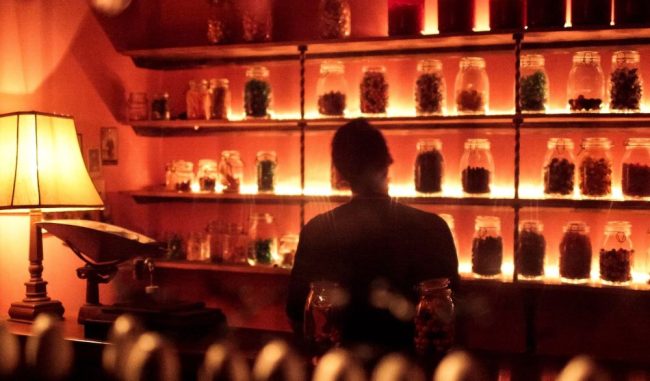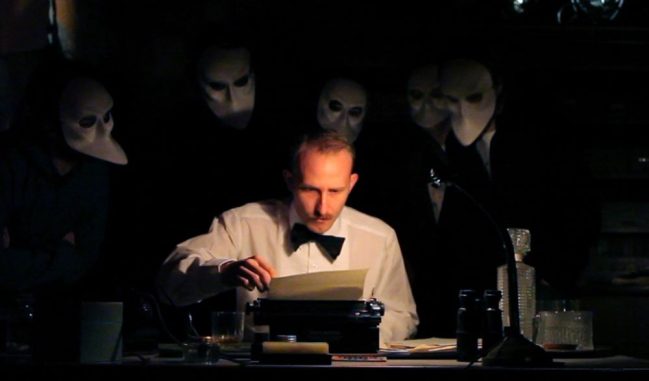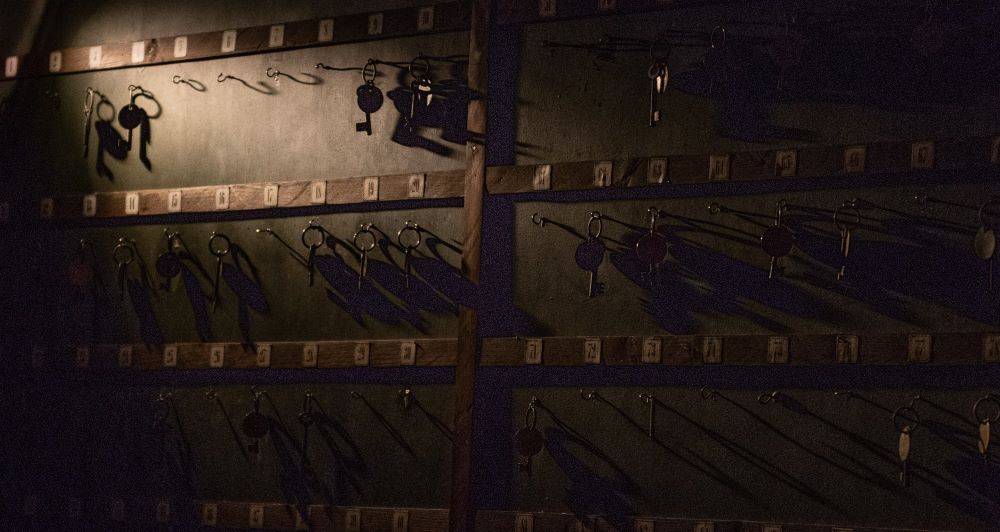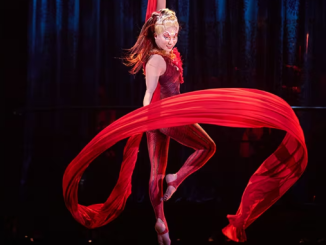Parting is such sweet sorrow.
After thirteen extraordinary, genre-defining years, Punchdrunk Entertainment’s legendary immersive theatrical experience Sleep No More is coming to an end. The original Sleep No More, staged in the relatively modest confines of London’s Beaufoy Building in 2003, was a minor success in the UK, only really taking off after its 2011 stateside relaunch – and major reinvention – at the (fictional) McKittrick Hotel in Manhattan’s Chelsea neighbourhood. (The hotel in fact a series of disused interconnected warehouses, painstakingly renovated by Punchdrunk over the course of several years.)
That version of Sleep No More became the runaway hit of the contemporary theatre scene, easily the most talked about non-Broadway show in decades. Subsequent London-set productions – The Drowned Man (2013-2014), The Burnt City (2022-2023) – further refined the Punchdrunk template – enormous, converted warehouse spaces where mask-wearing audiences wander through intricately realized worlds inhabited by dozens of characters – but none ever came close to the success of Sleep No More, even if, in certain respects, those latter productions were superior to the one that started it all.
But thirteen years is a long time, and accusations that Sleep No More had allowed itself to become the Disneyland of arthouse theatre were not entirely unfounded. That it eventually developed a cult-like following of obsessed fans, who’d see the show dozens of times and explore its every nook and cranny, was surely a sign it had overstayed its welcome. (A 2016 Shanghai transplant remains popular; once New York’s production ends in April 2024, SNM Shanghai will be the only active Punchdrunk production in the world.)
But now that the original is finally winding down, now that Punchdrunk, by their own admission, is going back to the drawing board to develop something new and different, the question remains: was the hype deserved? Was – is – Sleep No More truly the theatrical event of the twenty-first century, something that, with only a few months to go, curious theatregoers owe it to themselves to see?
The answer, dear friends, is a resounding yes.
While I believe Punchdrunk’s best work to be the too-briefly-lived The Burnt City (you can read my review here), Sleep No More is still an unequivocal masterpiece, the type of thing people will be talking about for years to come, long after the last red curtains have come down and the last ghost mask has faded.

In order to understand what Sleep No More is, it helps to understand what it is not.
Most emphatically, SNM is not a haunted house, although it does have ghosts – the sea of anonymous mask-wearing audience members – and witches and other weird things.
It is also not, by design, an entirely coherent narrative: done the right way – by which I mean, one, maybe two visits – you can expect to glimpse about one-quarter of the complete story, and properly explore perhaps half of its intricately detailed rooms and liminal spaces. Done the wrong way – like the SNM cultists who know the show inside out – it loses a lot of the magic, since the essence of SNM is a certain feeling of being part of something tantalizingly bigger, and only hinted at in glimpses. (This is also why I recommend visiting SNM with a friend, so you can compare notes on details you inevitably miss out on, including entire character arcs.)
SNM is, at its heart, a journey, one that takes you out of the familiar – one of the first things that happens is they lock away your phone – and into a wholly other space and time. For three hours – every Punchdrunk show runs three hours – you are free to explore its multistorey venue, limited by only a very few, very reasonable rules, including (1) do not speak, (2) do not remove your mask, and (3) do not touch the performers unless they approach you first. The cast – primarily dancers, who engage in various brilliantly choreographed dance sequences over the course of each three-hour performance – are the only ones without masks, making it easy to follow the action if you ever get lost.
Within those three hours, you have free rein to push and pull and poke and prod your way through a labyrinthine series of interconnected sets made up to look (and feel) like hotel lobbies, royal bedrooms, private detective agencies, funeral parlours, sanatoriums, moonlit forests, and so much more. And within each of those spaces, you are free – nay, encouraged – to open every drawer, leaf through every diary, explore every wardrobe, uncovering ever more clues, plot details, and, in lucky instances, some capital-S Secrets which only the select few have ever encountered.

Sleep No More is the most noirish of Punchdrunk’s three major productions, combining the basic plot elements of Shakespeare’s Macbeth with a 1940s cinematic aesthetic and a fantastic, era-appropriate soundtrack piped in through the “Hotel”‘s many speakers.
Other influences – the films of Alfred Hitchcock and David Lynch, Daphne du Maurier’s almost-ghost story Rebecca – are fun to spot, rewarding those who already have some familiarity with these and other thematically similar classics. That said, knowledge of anything other than Macbeth is not required, though I do recommend – as I did to everyone in queue before the show – watching Hitchcock’s 1958 cinematic masterpiece Vertigo, simply because everyone should watch Hitchcock’s 1958 cinematic masterpiece Vertigo.
In any event, it’s still possible to follow basic narrative threads even for those who’ve never read a word of Shakespeare in their life. Spend long enough with any one of the show’s twenty(!) characters, and you’ll start to get a feel for, if not their exact identity, then their motivations, their relationships, and their role in the broader story.
There is no one right way to do SNM (though, as mentioned, there is a wrong way, which is to see it too many times). Some people choose to meticulously scour every room for environmental details, hoping to come across some hidden compartment or a handwritten note in the margins of a doctor’s notebook, revealing a key detail about a particular character or event. Others pick a single character to follow for an extended period of time, hoping to follow their particular arc, even if it means that arc turns out to be tangential to the main plot, i.e. Macbeth and his Lady and all them witches.
Usually, it’s some combination of the above: for a while, you might be drawn to a particular character, only to follow them into some jaw-dropping new area, at which point you’ll abandon the plot and just wander around for a while. No matter what you choose, you’ll always be rewarded for it. To give one non-spoilery example from a decade-old show, I once went rummaging during The Drowned Man in a gardener’s shed, only to recoil in horror after my hands grazed something wet and slimy. It turned out to be the title character’s soaked clothing, mysteriously recovered from the lake where I had seen him drown an hour earlier.

If there are flaws to Sleep No More as it is in 2024, these are largely of the victim-of-one’s-own-success variety.
Punchdrunk obviously sells way more tickets than the space was originally designed for, meaning that crowds can quickly snowball to uncomfortable sizes, especially if you’re trying to follow one of the main characters. The Disneylandification of SNM also means there are far too many Hotel “guests” willing to break the rules – and a frustrating unwillingness of Punchdrunk staff to do anything about it. Hence the tourist couple loudly discussing which floor to visit next, or that one jerk who refuses to wear a mask, spoiling the immersion for the rest of us. These are, for what it’s worth, not problems I encountered in both London productions, and appear to be a particularly SNM/New York phenomenon.
That said, all the SNM overcrowding does have an unexpected benefit, in that there are even greater rewards for straying off the beaten path. Not only can it be a relief to get away from the horde chasing Lady Macbeth, it’s in those moments of quiet and solitude when you’re most likely to encounter something truly special, like a subtle character moment or an intriguing environmental detail you might have overlooked otherwise. The attention to detail – the decor, the lighting, the sounds, even the scents – is truly remarkable (it’s really what sets Punchdrunk apart from everyone else), and the more you pay attention, the more you are rewarded for it.
Sleep No More runs from now until April 28, 2024, barring any more extensions. That means just under two months to trek down to New York City, scarf down some bagels with lox, go for a run in Central Park, and maybe, just maybe, catch a coven of witches in action.
***
For tickets to Punchdrunk’s Sleep No More, click here.
For our review of Punchdrunk’s The Burnt City, click here.
For immersive theatre closer to home, check out our feature on Transcen|Dance’s Eve of St. George here.



